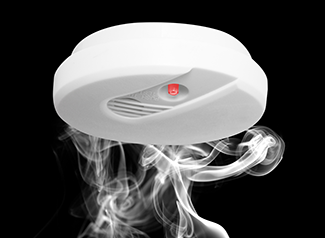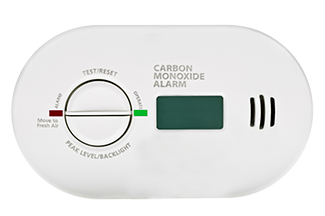Inspect & Test Home Alarm Systems Regularly
Inspect & Test Home Alarm Systems Regularly
Once we install our smoke, security, and carbon monoxide alarms it can be easy to forget they are there. It is critical that these alarms are maintained so they work at their maximum efficiency when you need it most – in an emergency.
It is critical that every household have an escape plan. Everyone should be able to get out of the house from their bedroom and know where to meet once outside. If you don’t have a plan now, make it a priority to create one and share it with everyone in your household.
Installing and maintaining smoke alarms
For many years NFPA 72, National Fire Alarm and Signaling Code, has required as a minimum that smoke alarms be installed inside every sleep room (even for existing homes) in addition to requiring them outside each sleeping area and on every level of the home. (Additional smoke alarms are required for larger homes.)
There are two types of smoke alarms – ionization and photoelectric.
1 | Ionization | Generally more responsive to flaming fires, triggered by the small particles given off by an open flame so an active kitchen will often produce false alarms. They’re better installed near steamy bathrooms.
2 | Photoelectric | Generally more responsive to smoldering fires. They respond to particles in the air, created by smoldering fires or steamy showers. Because they are less prone to false alarms caused by cooking, place them in areas near the kitchens.

For the best protection, both types of alarms or combination - ionization photoelectric alarms, also known as dual sensor smoke alarms, are recommended.
Consumer Reports recommends the First Alert 3120B or this Kidde P12010.
The National Fire Protection Association offers these tips for installing and maintaining smoke alarms.
Installation
- Choose smoke alarms that have the label of a recognized testing laboratory.
- Install smoke alarms inside each bedroom, outside each sleeping area and on every level of the home, including the basement.
- On levels without bedrooms, install alarms in the living room (or den or family room) or near the stairway to the upper level, or in both locations.
- Smoke alarms installed in the basement should be installed on the ceiling at the bottom of the stairs leading to the next level.
- Smoke alarms should be installed at least 10 feet (3 meters) from a cooking appliance to minimize false alarms when cooking.
- Mount smoke alarms high on walls or ceilings (remember, smoke rises). Wall-mounted alarms should be installed not more than 12 inches away from the ceiling (to the top of the alarm).
- If you have ceilings that are pitched, install the alarm within 3 feet of the peak but not within the apex of the peak (four inches down from the peak).
- Don't install smoke alarms near windows, doors, or ducts where drafts might interfere with their operation.
- Never paint smoke alarms. Paint, stickers, or other decorations could keep the alarms from working.
- For the best protection, interconnect all smoke alarms. When one smoke alarm sounds, they all sound. Interconnection can be done using hard-wiring or wireless technology.
- When interconnected smoke alarms are installed, it is important that all of the alarms are from the same manufacturer. If the alarms are not compatible, they may not sound.
- Keep manufacturer’s instructions for reference.
Testing
- Smoke alarms should be maintained according to manufacturer’s instructions.
- Test smoke alarms at least once a month using the test button.
- Make sure everyone in the home understands the sound of the smoke alarm and knows how to respond.
- Follow manufacturer’s instructions for cleaning to keep smoke alarms working well. The instructions are included in the package or can be found on online.
- Smoke alarms with non-replaceable 10-year batteries are designed to remain effective for up to 10 years. If the alarm chirps, warning that the battery is low, replace the entire smoke alarm right away.
- Smoke alarms with any other type of battery need a new battery at least once a year, perhaps on New Year’s Day whether they need it or not. A chirping alarm is a warning that the battery is low. Replace the battery right away.
- When replacing a battery, follow manufacturer’s list of batteries on the back of the alarm or manufacturer’s instructions. Manufacturer’s instructions are specific to the batteries (brand and model) that must be used. The smoke alarm may not work properly if a different kind of battery is used.
Interconnected smoke alarms increase safety
In a Consumer Product Safety Commission (CPSC) survey of households with any fires, including fires in which the fire department was not called, interconnected smoke alarms were more likely to operate and alert occupants to a fire.

False Alarms
The most likely reason smoke detectors go off unexpectedly is because the batteries haven’t been changed.
Most smoke detectors are designed to go off when their electrical current goes down. That’s because smoke in the air will reduce the current. If your battery is dying, the current that’s flowing through your sensor also goes down, creating a false positive.
The second most common cause of false positives is placing a smoke detector too close to the bathroom. Steam from a hot shower can cause false positives and block the flow of the current, just as smoke does.
Volatile organic compounds in paints or other chemical treatments in the house can also set off the alarm. Be sure new paint is dry before replacing the alarm on the wall.
Carbon Monoxide Detectors
If you heat your home with a gas furnace or use other gas appliances at home, you must install carbon monoxide (CO) detectors. You can’t see or smell carbon monoxide, which is a potential byproduct of burning fossil fuels.

Install a CO detector on every floor of the house and inside every bedroom. Your home should have at least one carbon monoxide detector to alert you of the presence of gas. Follow these safety guidelines:
- If you install only one carbon monoxide detector, put it near the bedrooms so it can alert your family to wake up in case levels of the gas reach an unhealthy level.
- Follow the manufacturer’s instructions for where to place the detector on the wall.
- A rule of thumb: Place CO detectors at a minimum of 5-feet above the finish floor where they will stay dust-free and where children and pets won’t bother them.
- Keep your detectors at least 15 feet away from a gas stove or oven, which may emit a small amount of carbon monoxide on startup.
- Detectors don’t operate properly in humid areas like the bathroom.
- Replace the batteries in your alarms at least once a year test them often.
- Properly maintain your gas appliances, including the furnace and stove. Same goes for devices that use gasoline.
- Know the warning signs of too much carbon monoxide in the house: Stuffy, stale air; condensation on windows; yellow burner flames on the stove; and fluttering or extinguishing pilot lights.
Radon Detection
Radon comes from the natural (radioactive) breakdown of uranium in soil, rock, and water and gets into the air you breathe. Radon can enter a home through cracks in the foundation floor and walls, through basement floor drains, and through sump openings. Homes with dirt crawl spaces have increased radon exposure levels. However, even houses with a seemingly tight concrete foundation can have high radon levels.
We cannot smell, taste, see, touch, or hear radon. Thus, it easily goes unnoticed. While you can buy radon alarms online and in some home service centers, we recommend that you hire a professional radon specialist to test your home and the mitigate the issue. Rosie Certified Partner, Arizona Foundation Solutions . offers such a service.
Security Alarm
 One of the single-greatest deterrents when it comes to keeping a home safe is a good-functioning and monitored home security system. Hard-wire your home or install a wireless security system and link it to a monitoring service that will call you or dial 911 if a window or door opens when it’s not supposed to. Contact your monitoring service to confirm whether they will call you and the police.
One of the single-greatest deterrents when it comes to keeping a home safe is a good-functioning and monitored home security system. Hard-wire your home or install a wireless security system and link it to a monitoring service that will call you or dial 911 if a window or door opens when it’s not supposed to. Contact your monitoring service to confirm whether they will call you and the police.
Some systems include smoke detectors and carbon monoxide detectors that trigger the service when detected.
False Alarm
A false alarm occurs when your security system signals your alarm monitoring company that there’s a problem at your house, when there isn’t one. Many cities may issue a fine to the homeowner, when police or fire officials respond to a false alarm triggered by a security system.
Prevent security system false alarms with these tips:
- Teach everyone in your family how to properly use the alarm system and what to do if someone sets it off by accident. Make sure everyone knows the passwords for the alarm’s keypad. Punching in the wrong code can trigger an alarm.
- Keep the phone number for your security monitoring company near the phone or the alarm’s keypad so you can call it in a hurry to cancel a false alarm.
- Lock all windows and doors before arming your system. An unlocked entry can trigger a false alarm. Extreme heat can cause window and door frames to swell or bow, loosening the lock and thus, trigger a false alarm.
- Regularly update your contact information with your monitoring company so you’re easy to reach if your home has a problem. If the company can’t reach you, someone there probably will call the police.
- If you have cats, don’t use motion detectors. They tend to trigger false alarms.
- Don’t leave a balloon in a room that has a motion detector.
Arm Yourself with an Alarm
Installing, maintaining, and testing your home’s alarm systems is imperative to your family’s safety. This is not a consideration of your home in which you should cut corners.
Home Maintenance Calendar To-Do | #AlarmSystem
Podcast
Our Weekly To Do on smoke, fire and carbon monoxide home alarms. Daisy Mountain Fire Department's PIO Brent Finton discusses how these alarms work, proper maintenance, the importance of physical placement in each room of the home, battery and shelf life, and the importance of having an escape plan. We also cover the Most Asked Question Of The Week: "I don't like my home. What can I do about it?". We share tips and also ask the question: is it worth remodeling or or should I move out?
###
Photo Credit
- Shutterstock
Related Content
- Certified Partner: TEKNA SECURITY & SMARTHOME, LLC
- Certified Partner: Arizona Foundation Solutions
- DIY FAQ: How Can I Prevent Security-System False Alarms?
- DIY FAQ: What Are Some Tips For Buying And Installing Smoke Alarms?
- DIY FAQ: Rosie's Home Security Consumer Guide
- DIY FAQ: Where Should I Install Carbon Monoxide Detectors?
- DIY FAQ: Deadly Home Invasion: Radon
- DIY FAQ: What You Need To Know About Radon
- External Resource: National Fire Prevention Association
